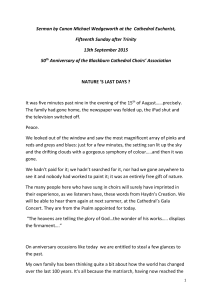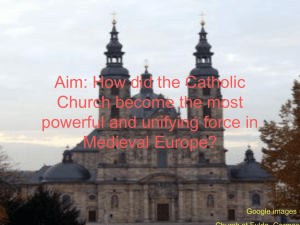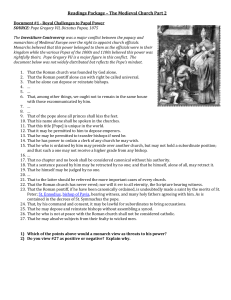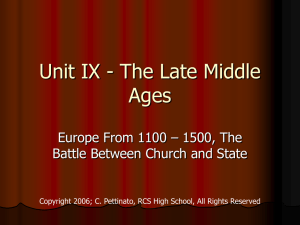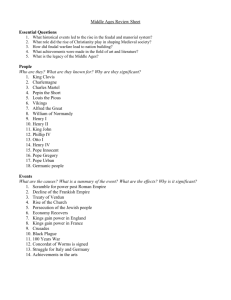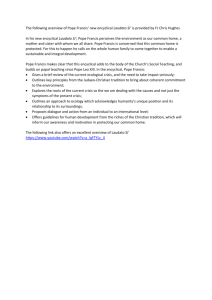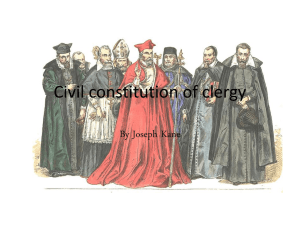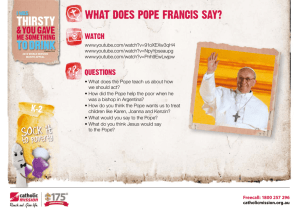Medieval Church Reform and Conflict
advertisement
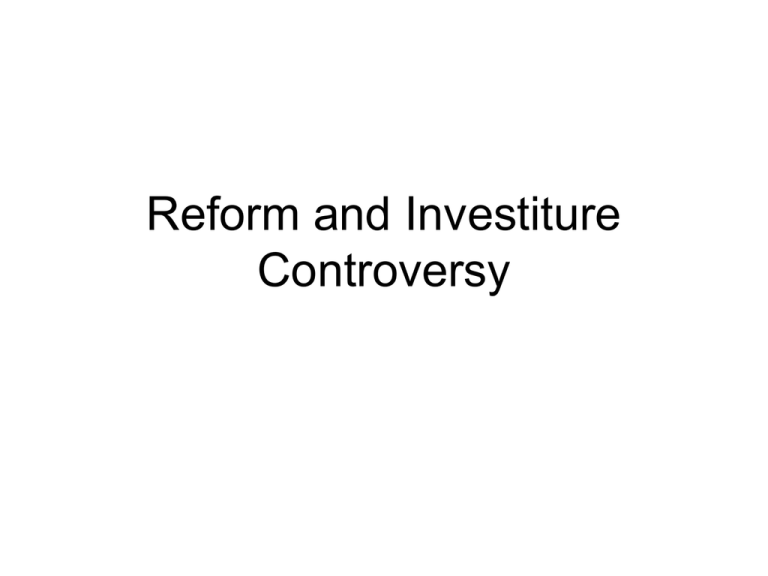
Reform and Investiture Controversy Europe in 1100 Otto III (b. 983, r. 996-1002) seated in majesty, flanked by clerics and dukes Henry II of Germany (1002-24) as king crowned by God (with two saints, Bishop Udalrich of Augsburg and Bishop Emmeren of Regensburg) Emperor Henry III of Germany (1039-1056) Sponsored reform movement against simony and clerical marriage Emperor Henry III fighting simony (represented as a dragon) Archbishop Lanfranc of Canterbury (late eleventh century) Pope Gregory VII (1073-1085) Emperor Henry IV 1056-1106 Opponent of Gregorian Reformers Dictates of the Pope, entered into Papal Register of Gregory VII in 1075 • • • • • • • • • • • • • • • • • • • • • • • • • • • • The Dictates of the Pope That the Roman church was founded by God alone. That the Roman pontiff alone can with right be called universal. That he alone can depose or reinstate bishops. That, in a council his legate, even if a lower grade, is above all bishops, and can pass sentence of deposition against them. That the pope may depose the absent. That, among other things, we ought not to remain in the same house with those excommunicated by him. That for him alone is it lawful, according to the needs of the time, to make new laws, to assemble together new congregations, to make an abbey of a canonry; and, on the other hand, to divide a rich bishopric and unite the poor ones. That he alone may use the imperial insignia. That of the pope alone all princes shall kiss the feet. That his name alone shall be spoken in the churches. That this is the only name in the world. That it may be permitted to him to depose emperors. That he may be permitted to transfer bishops if need be. That he has power to ordain a clerk of any church he may wish. That he who is ordained by him may preside over another church, but may not hold a subordinate position; and that such a one may not receive a higher grade from any bishop. That no synod shall be called a general one without his order. That no chapter and no book shall be considered canonical without his authority. That a sentence passed by him may be retracted by no one; and that he himself, alone of all, may retract it. That he himself may be judged by no one. That no one shall dare to condemn one who appeals to the apostolic chair. That to the latter should be referred the more important cases of every church. That the Roman church has never erred; nor will it err to all eternity, the Scripture bearing witness. That the Roman pontiff, if he have been canonically ordained, is undoubtedly made a saint by the merits of St. Peter; St. Ennodius, bishop of Pavia, bearing witness, and many holy fathers agreeing with him. As is contained in the decrees of St. Symmachus the pope. That, by his command and consent, it may be lawful for subordinates to bring accusations. That he may depose and reinstate bishops without assembling a synod. That he who is not at peace with the Roman church shall not be considered catholic. That he may absolve subjects from their fealty to wicked men. From the History of Henry IV: Gregory VII driven from Rome, 12th cent ms. Pope Gregory VII (1073-1085) • Pope Gregory VII, after his expulsion from Rome, laying a ban of excommunication on the clergy “together with the raging king” (Henry IV of Germany), drawing from the 12th-century chronicle of Otto of Freising; in the library of the University of Jena, Germany. Frederick I Barbarossa (1122-90; king of Germany, 1152-90; Roman Emperor, 1155-90) Charterhouse of Trisulti, built by Innocent III Trisulti (Interior) Tower of the Conti, Rome built by Pope Innocent III (birth name Lotario de’ Conti de Segni), 1203 Earliest Portrait of St. Francis, Subiaco c. 1218 (Francis, 1181-1226, canonized 1228) His tunic was filthy, his figure contemptible and his face far from handsome. Yet God gave such force to his words that many factions of the nobility, the fury of whose ancient feuds had shed so much blood among thorn, made peace together. The reverence and devotion of people towards him was so great that men and women rushed upon him, trying to touch the hem of his garment and carry off pieces of his clothing.” • “ • Thomas of Spalato, August 15, 1222, eyewitness account by a non-Franciscan of Francis’ preaching at Bologna Innocent III receives St. Francis (Giotto, Church of San Francesco in Assisi,1305) Dream of Pope Innocent III (Giotto, Church of San Francesco in Assisi,1305) St. Francis receives the stigmata (Giotto, Church of San Francesco in Assisi,1305) Porziuncola (near Assisi), church that St. Francis rebuilt with his own hands, 1208 San Maria degli Angeli, built 1569-1667 to enclose the San Francesco, Porziuncola Basilica of San Francesco d’Assisi begun immediately after St. Francis’ canonization in 1228, completed 1253. Francis’ body was entombed there in 1230 Martyrdom of Peter of Castelnau, 1208 Beziers, massacre 1209 (Papal Legate Arnaud Aimery: “Kill them all; God will know his own”) Crusaders expel citizenry from Carcassone so they can loot the city, 13th century Montsegur Surrundered in 1224: 220 perfects burned
